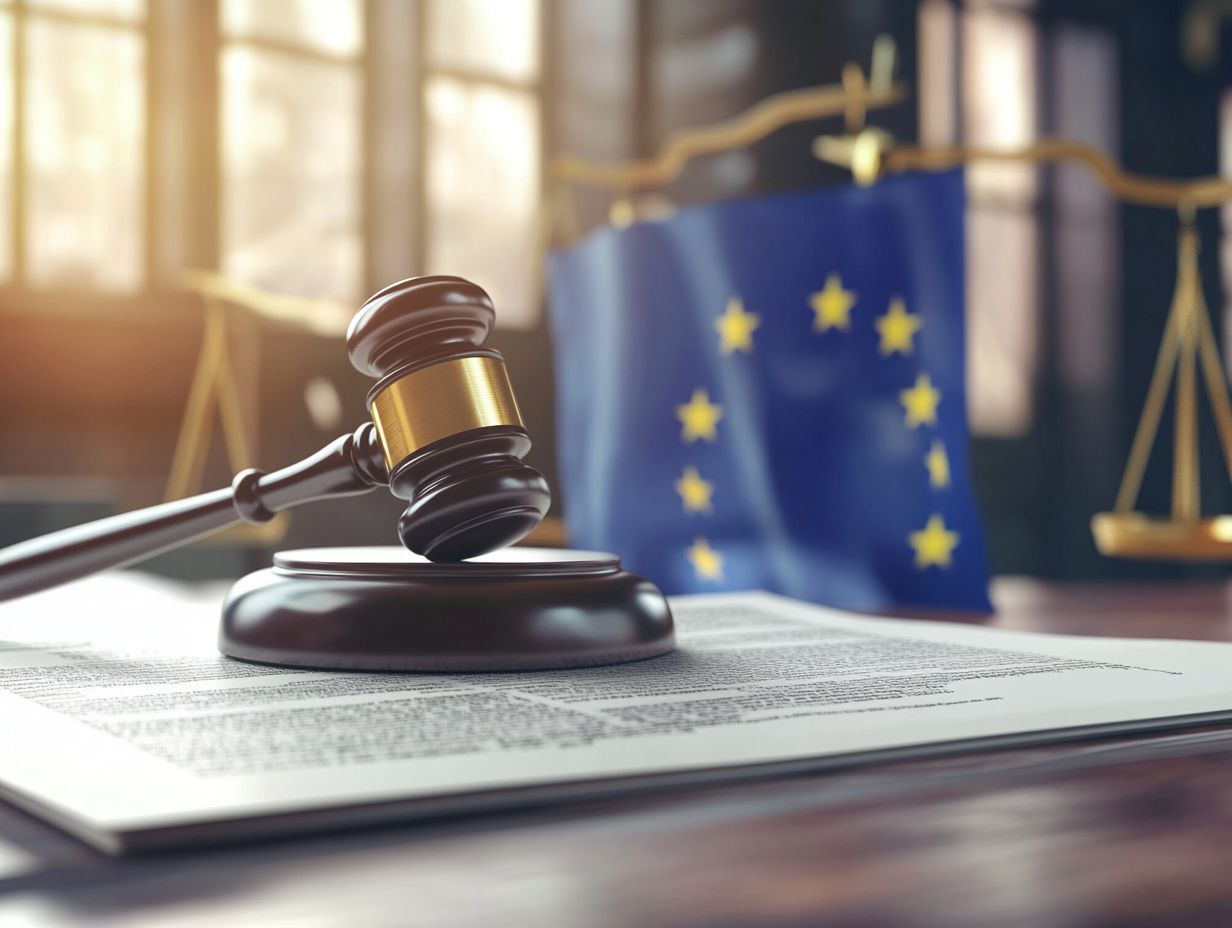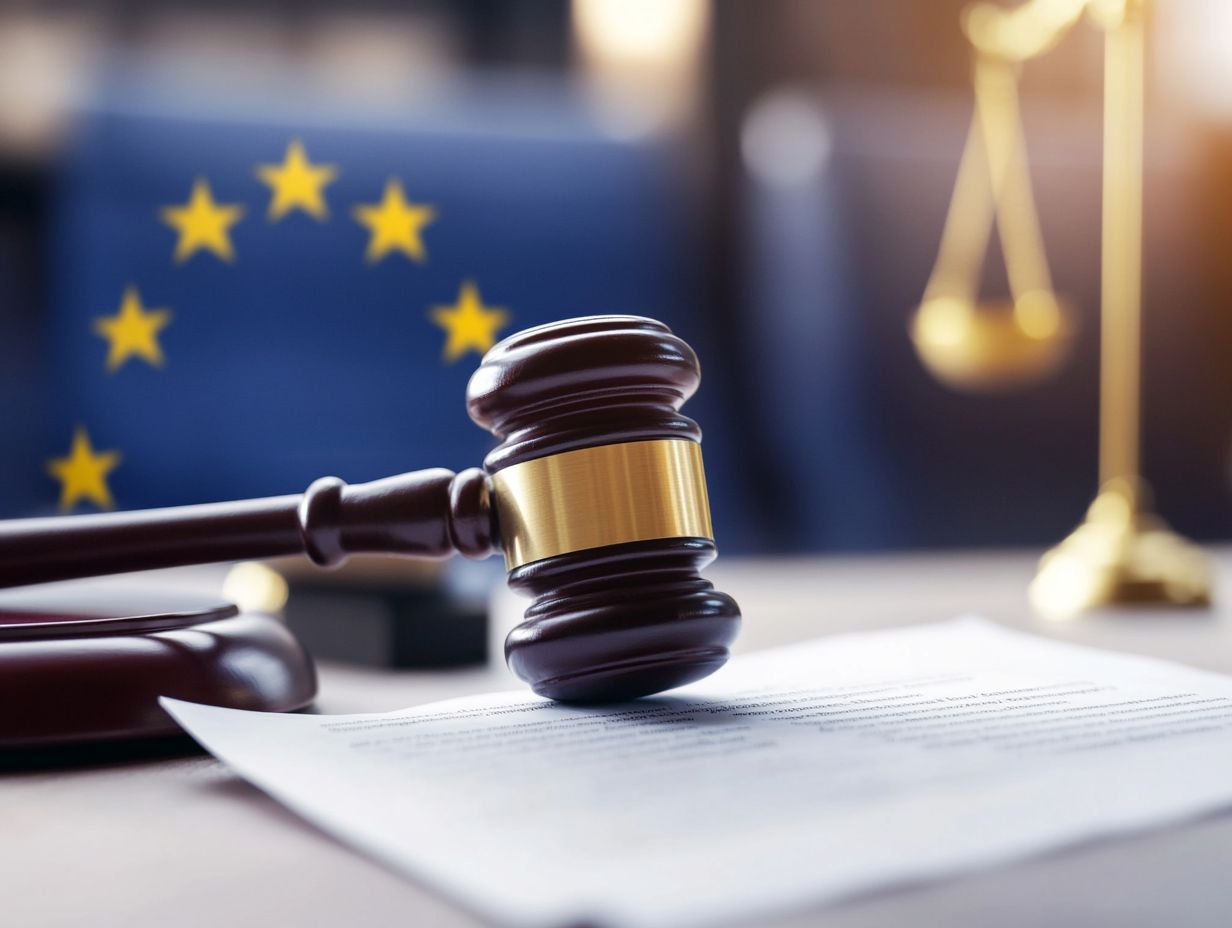Understanding Patent Law in Europe
Navigating patent law in Europe might appear intimidating at first glance, yet it is vital for protecting new ideas.
This overview delves into the essence of a patent, shedding light on the fundamental principles that govern European patent law and outlining the essential requirements for securing one.
Discover the various types of patents available, the application process you ll need to follow, and the ways you can enforce and defend your rights against infringement.
Dive in to uncover the complexities of patent law and let your inventions shine and thrive!
Contents
Key Takeaways:

A patent is your key to exclusive rights over your invention in Europe.
To get a patent, your invention must be new, inventive, and applicable in industry.
There are two types of patents in Europe: European patents and unitary patents. The process for obtaining a patent involves filing an application and going through examination and granting procedures.
Overview of Patent Law in Europe
The patent law landscape in Europe presents a sophisticated framework tailored to protect innovative inventions and protect your creative work throughout the European Union. This framework emphasizes established procedures, including the patent application process, examination reports, and the legal titles tied to patents.
As you navigate this overview, you’ll delve into the complexities of the European Patent Office, unified patent systems, and the critical requirements for obtaining patent protection for a diverse array of inventions, particularly in biotechnology and other technical domains.
What is a Patent?
A patent is a legal title granted by a governmental authority that gives you exclusive rights to exploit your invention, typically for a specified period. This means others cannot use, make, or sell your patented creation without your permission.
This exclusivity protects your financial investment and fosters the development of new technologies and products. The inventions eligible for patenting are quite diverse; they can include processes, machines, manufactured items, or even compositions of matter, as long as they meet certain criteria.
Among these criteria, the technical character of your invention is paramount, requiring novelty, non-obviousness, and utility. These standards ensure that your inventions are not only innovative but also practical, highlighting the importance of patent rights in advancing industry and safeguarding your contributions to society.
General Principles of European Patent Law
European Patent Law is primarily shaped by the European Patent Convention (EPC), which lays out the essential principles and processes for securing a European patent. It emphasizes the necessity for novelty, an inventive step, and a clear disclosure of the invention in your patent application.
This legal framework rigorously evaluates innovations to ensure that patents aren t granted for ideas that lack originality or inventive merit. The novelty requirement mandates that your invention must be new compared to existing knowledge, while the inventive step ensures it isn t obvious to a skilled individual in the relevant field.
Throughout the examination process, your patent application will face thorough scrutiny, including an assessment of prior art previously published works that could challenge the validity of your patent claims.
The EPC plays a crucial role in harmonizing these procedures across member countries, fostering a streamlined approach that enhances legal certainty for inventors and businesses throughout Europe.
Requirements for Obtaining a Patent in Europe

To successfully secure a patent in Europe, you must navigate several essential requirements. This includes demonstrating novelty, showcasing an inventive step, and proving the potential for industrial application.
Together, these criteria establish the patentability of your invention under the European Patent Convention.
Novelty and Inventive Step
Novelty and inventive step are essential for patentability. Novelty means your invention must be new; nothing like it should have been disclosed in previous patents or publications.
The inventive step requires your invention to be a significant advancement, not obvious to someone skilled in the field.
Patent examiners carefully review all existing patents and publications in the relevant area. This prior art is crucial as it measures your invention’s uniqueness.
For instance, if you propose a new smartphone feature, it might be rejected if it’s similar to something in past patents. However, if you invent a unique energy storage method, you’re likely to get a patent if it shows a clear advancement.
This illustrates how novelty and the inventive step criteria apply in practice.
Industrial Application
Your invention must have industrial application, meaning it should be useful in any industry. This ensures your innovation can make a real difference in the market.
This requirement sparks creativity and fuels economic growth, motivating you to develop products that address real-world needs. For example, wind turbines and solar panels show how patents can drive industries toward sustainable solutions.
Innovations in healthcare, such as targeted drug delivery systems, highlight the connection between practical use and advancements in medicine. When your inventions have practical applications, they fulfill legal requirements and promote innovation.
Types of Patents in Europe
In Europe, you can access various types of patents that fit your needs. European patents offer strong protection across all EPC countries, ensuring your innovation is safe.
Unitary patents simplify the process for EU members, making it easier to navigate patenting. Supplementary protection certificates extend your patent rights for pharmaceutical products, giving extra security to your creations.
European Patents

The European Patent Office (EPO) grants European patents through a clear application process. This allows you to gain patent protection across multiple EPC countries with one application.
You start the journey by submitting a complete application, including your patent claims, a detailed description, and necessary drawings. Once filed, the EPO reviews your application to ensure it meets all legal and technical standards.
During this examination, the EPO checks the novelty and inventive step of your invention. This is key in deciding if you qualify for patent protection.
Compared to national patents, a European patent can streamline your path as an inventor. It cuts costs and reduces administrative burdens while offering extensive protection across member states.
Unitary Patents
The unitary patent system simplifies patent protection in EU member states. You can secure a single patent that is enforceable across these countries.
This approach streamlines the licensing agreement process and enhances your strategic advantage. It also reduces the administrative burden of managing patents in different countries.
As a patent holder, you enjoy more coherent and efficient management of your intellectual property. This can stimulate innovation and attract investment.
The unitary patent is linked to the Unified Patent Court, a specialized tribunal that provides a centralized forum for resolving patent disputes. This connection gives you a clear legal pathway, making it easier to navigate the European patent landscape and seize your competitive edge!
Process for Obtaining a Patent in Europe
The journey to securing a patent in Europe encompasses several essential stages.
It begins with careful preparation and submission of your patent application. Following this, the patent office conducts a comprehensive examination of your submission.
If all requirements are met, you may ultimately receive the coveted grant of your patent.
Filing a Patent Application
Filing a patent application is a vital step in the patent process. You must prepare a detailed patent specification that thoroughly describes your invention and its technical features.
Establishing a priority date for your patent rights is essential. A priority date is when you first file your patent application. It helps determine who has rights to the invention if disputes arise.
This process demands your attention to clarity and completeness. Every aspect of your invention must be precisely articulated.
The claims section is particularly critical, as it defines the scope of protection you seek. It allows others to understand which aspects of your invention are novel and legally protected.
Securing an early priority date can effectively prevent others from patenting similar innovations, safeguarding your competitive edge in the market.
Examination and Granting of a Patent

The process of examining and granting a patent involves a meticulous review by the patent office to determine whether your application meets all legal and technical requirements. This scrutiny ultimately leads to a decision about the validity of your patent and the associated costs of the process.
During this examination, examiners consider several crucial factors, such as the novelty of your invention and its non-obviousness. They also assess how well it aligns with existing patents and literature.
Examiners may issue office actions to seek clarification or request modifications. This can affect the timeline for your patent grant, often extending it by several months or even years.
Be ready for possible rejections or requests for more information, as these can drive up costs. By conducting a prior art search early and collaborating with experienced patent attorneys, you can manage these expenses more effectively and streamline your journey to securing your intellectual property.
Enforcing and Defending Patents in Europe
Enforcing and defending patents in Europe is essential for upholding your rights.
This process may involve navigating potential patent litigation to protect against infringement. You should also explore various legal remedies and opposition procedures when challenges arise.
This strategic endeavor demands careful attention and expertise to effectively safeguard your innovations.
Infringement and Validity
Patent infringement occurs when someone uses, makes, or sells a patented invention without permission. This raises important questions about the patent’s validity and ownership.
Unauthorized use can happen in different ways. There’s direct infringement, where someone copies the invention, and indirect infringement, where someone helps another infringe.
If you’re facing violations, you must navigate a complex process to dispute infringement claims. Gathering strong evidence is essential to support your patent’s validity for now and future cases.
Keeping your patent valid is vital! It protects you from competitors who might try to steal your ideas. Patent attorneys are your allies, guiding you through legal processes to enforce your rights.
They help craft strong defense strategies and prepare necessary documents. Their expertise can greatly influence the outcome of infringement disputes, showing how crucial legal support is for protecting your intellectual property.
Legal Remedies for Patent Infringement
Legal remedies for patent infringement include injunctions, damages, and sometimes additional protection to enforce your rights. These remedies are key to maintaining your intellectual property.
If you think your patent rights are violated, you can seek an injunction to stop further infringement. You can also seek monetary damages to recover losses caused by the infringement.
To access these remedies, you need to prove your patent’s validity and show that infringement occurred, along with the harm suffered.
Mediation and arbitration are excellent options for resolving disputes outside of court. These alternatives often lead to faster and cheaper resolutions.
Frequently Asked Questions
What is patent law in Europe?
Patent law in Europe is the legal framework that governs the creation and protection of patents for inventions. It promotes innovation by giving inventors exclusive rights to their inventions for a set time.
What is the purpose of understanding patent law in Europe?
Understanding patent law helps businesses and inventors protect their inventions from being copied. It also allows them to take action against those who infringe on their rights.
How is patent law in Europe different from other regions?
Patent law in Europe is governed by the European Patent Convention (EPC), offering a unified system for 38 countries. This differs from places like the U.S., where patents are granted nationally.
What types of inventions can be patented in Europe?
Inventions eligible for patent protection in Europe must be new, involve an inventive step, and have industrial applicability. This includes products, processes, and even software.
What is the process for obtaining a patent in Europe?
To obtain a patent in Europe, you file an application with the European Patent Office (EPO). They will examine it to see if it meets the requirements for a patent.
How long does a patent last in Europe?
A patent in Europe generally lasts for 20 years from the application date. Factors like maintenance fees and extensions can affect this duration.






